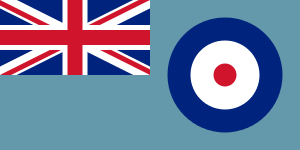No. 71 Squadron RAF
| No. 71 Squadron RAF | |
|---|---|
|
Official badge of No. 71 Squadron RAF | |
| Active |
27 March 1917 – 19 January 1918 19 September 1940 – 29 September 1942 16 September 1950 – 30 April 1957 |
| Country |
|
| Branch |
|
| Role | Fighter |
| Nickname | Eagle |
| Motto | First from the eyries |
| Insignia | |
| Squadron Badge heraldry | A bald-headed eagle displayed charged with three stars of nine points |
| Post 1950 Squadron Roundel |
 |
| Squadron Codes |
XR (November 1940 – September 1942, also used initially on transfer to USAAF) L (September 1950 – October 1953) |
No. 71 Squadron was a Royal Air Force aircraft squadron. The number has been used three times: once by the Royal Flying Corps for an Australian Flying Corps squadron; in the Second World War as an Eagle Squadron; and post-war as a fighter-bomber unit under the command of Royal Air Force Germany.
History
First World War
The first unit known by the British military as "No. 71 Squadron" was No. 4 Squadron, Australian Flying Corps (AFC), during the First World War. The squadron was formed at Point Cook, Victoria, Australia on 16 October 1916, after which it travelled to England. From 27 March 1917, while based at Castle Bromwich, it was designated "No. 71 Squadron" by the Royal Flying Corps, to avoid confusion with No. 4 Squadron, RFC. This name was never officially adopted by the Australian Imperial Force.
4 Sqn AFC arrived in France on 18 December 1917. With Sopwith Camels, it performed fighter sweeps, provided close air support and raided German airfields. In spite of its relatively short service during the First World War, 11 of its pilots became aces, including Captain Harry Cobby, the AFC's leading ace of the war, who was credited with destroying 29 aircraft and 13 observation balloons. Besides Cobby, Elwyn King, future Air Vice-Marshal Edgar McCloughry, Herbert Watson, Thomas Baker, Leonard Taplin, Thomas Barkell, future Air Marshal George Jones, Norman Trescowthick, and Garnet Malley served as aces in the unit.[1]
On 19 January 1918, British usage of "No. 71 Squadron" for this unit also ceased. The squadron spent some time with the Army of Occupation in Germany after the Armistice and was disbanded there at Bickendorf on 28 February 1919.[2]
American Eagles

At the start of the Second World War before the US entered the war, there were a large number of American volunteers offering their services. . No. 71 was formed at RAF Church Fenton on 19 September 1940 with Brewster Buffalos. Appraisal by Royal Air Force acceptance personnel criticised the Brewster Buffalo on numerous points including lack of armament and pilot armour, poor high-altitude performance, engine overheating, maintenance issues, and cockpit controls, while it was praised for its handling, roomy cockpit, and visibility.[3] The aircraft were deemed unsuitable for European conditions and Hawker Hurricanes replaced them from November 1940. The squadron became operational at RAF Kirton-in-Lindsey on 5 February 1941 but moved in April to RAF Martlesham Heath. The squadron's first confirmed victory came on 21 July 1941 during a bomber escort mission when Pilot Officer Dunn destroyed a Bf 109F over Lille.[4] On 29 September 1942 the squadron, together with the other two Eagle squadrons, was transferred to the US Army Air Forces becoming the 334th Fighter Squadron of the 4th Fighter Group.
Into the jet age
On 16 September 1950 a new 71 Squadron was formed at RAF Gütersloh with de Havilland Vampire fighter-bombers, joining the Second Tactical Air Force. In October 1953 it became a "day fighter" unit with the North American Sabre. The Sabres were replaced by Hawker Hunters in April 1956. The squadron moved to RAF Bruggen in May 1956 and disbanded on 30 April 1957.
Aircraft operated
| Dates | Aircraft[5] | Variant | Notes |
|---|---|---|---|
| Jun 1917 – Oct 1917 | Various | ||
| Oct 1917 – Jan 1918 | Sopwith Camel | Australian Flying Corps | |
| Oct 1940 – Nov 1940 | Brewster Buffalo | I | |
| Nov 1940 – May 1941 | Hawker Hurricane | I | |
| Apr 1941 – Aug 1941 | Hawker Hurricane | IIB | |
| Aug 1941 – Sep 1941 | Supermarine Spitfire | IIA | |
| Sep 1941 – Sep 1942 | Supermarine Spitfire | VB | |
| Oct 1950 – Oct 1953 | De Haviland Vampire | FB.5 | |
| Oct 1953 – May 1956 | North American Sabre | F.4 | |
| Apr 1956 – Apr 1957 | Hawker Hunter | F.4 |
Notable members
- Art Donahue. Air ace.
See also
References
Notes
Bibliography
- Childers, James Saxon. War Eagles: The Story of the Eagle Squadron. Windmill Press, 1943.
- Republished by Eagle Publishing in 1983, ISBN 0-941624-71-4. Same as the 1943 edition, except it has an epilogue of the members in 1982.
- Halley, James J. The Squadrons of the Royal Air Force & Commonwealth, 1918–1988. Tonbridge, Kent, UK: Air-Britain (Historians) Ltd., 1988. ISBN 0-85130-164-9.
- Rawlings, John D.R. Fighter Squadrons of the R.A.F. and their Aircraft. London: Macdonald an Jane's (Publishers) Ltd., 1978. ISBN 0-354-01028-X.
External links
| Wikimedia Commons has media related to No. 71 (Eagle) Squadron RAF. |
- Nos. 71–75 Squadron Histories
- RAF Eagle Squadron (historic video)
- Eagle Squadrons became the USAAF 4th Fighter Group. 4th Fighter Group Association Site
| ||||||||||||||||||||||||||||||||||||||||||||||

